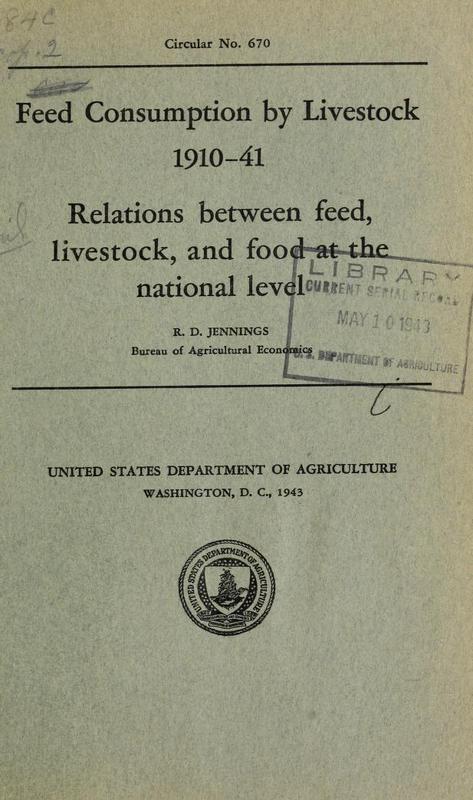Feed Consumption by Livestock, 1910-41: Relations Between Feed, Livestock, and Food at the National Level
Creator
Date
1943
Subject
Excerpt
Feed for livestock suddenly becomes of crucial importance in meeting the crucial needs of the United Nations for food. For 10 years the emphasis of agricultural leaders has been on holding down the over- abundant supplies of feed and keeping the fertility in the soil against a time of need. That time is here and now. Milk, meat, eggs, must be produced in quantities never before attempted. Production of feed is the principal occupation of many farmers and is of at least secondary importance on most other farms. How this feed is produced and utilized is now of prime concern.
In answering the question as to how much more feed is needed to produce a given quantity of milk or hogs or eggs, it is necessary to know how much feed of the different kinds it takes to produce 100 pounds of milk, hogs, or a dozen eggs under average conditions. When the total quantity of feed needed is known, it is then possible to ascertain whether the goals of livestock production are realizable, and to determine changes in the production of feed and in feeding practices that will facilitate the attainment of the desired goals.
The principal contribution of this circular to this problem is found in the data on feed consumption per unit of livestock which is given in several tables. The data on livestock numbers and livestock production and feed production used in arriving at the rates of feed consumption in these tables are the official estimates of the Department of Agriculture insofar as they are available. The data used herein are averages for the United States and are thus made up of information that is representative of a variety of conditions which may differ widely from the average in feed requirements for a particular product. Beef cattle in the Southwest, for instance, get almost all their feed from grass; in the East much hay and corn fodder are fed, and some grain; in Corn Belt feed lots, cattle get a heavy feed of corn. Dairy cows in the East get a heavy grain ration; in the West less grain and more hay are fed. These data therefore are not applicable as they stand in any one region, State, or smaller territory, and this is especially true of the data for cattle and sheep. Utilization of the feed resources of the country at the national level is considered here.
In answering the question as to how much more feed is needed to produce a given quantity of milk or hogs or eggs, it is necessary to know how much feed of the different kinds it takes to produce 100 pounds of milk, hogs, or a dozen eggs under average conditions. When the total quantity of feed needed is known, it is then possible to ascertain whether the goals of livestock production are realizable, and to determine changes in the production of feed and in feeding practices that will facilitate the attainment of the desired goals.
The principal contribution of this circular to this problem is found in the data on feed consumption per unit of livestock which is given in several tables. The data on livestock numbers and livestock production and feed production used in arriving at the rates of feed consumption in these tables are the official estimates of the Department of Agriculture insofar as they are available. The data used herein are averages for the United States and are thus made up of information that is representative of a variety of conditions which may differ widely from the average in feed requirements for a particular product. Beef cattle in the Southwest, for instance, get almost all their feed from grass; in the East much hay and corn fodder are fed, and some grain; in Corn Belt feed lots, cattle get a heavy feed of corn. Dairy cows in the East get a heavy grain ration; in the West less grain and more hay are fed. These data therefore are not applicable as they stand in any one region, State, or smaller territory, and this is especially true of the data for cattle and sheep. Utilization of the feed resources of the country at the national level is considered here.
Title
Feed Consumption by Livestock, 1910-41: Relations Between Feed, Livestock, and Food at the National Level
 An official website of the United States government.
An official website of the United States government.


